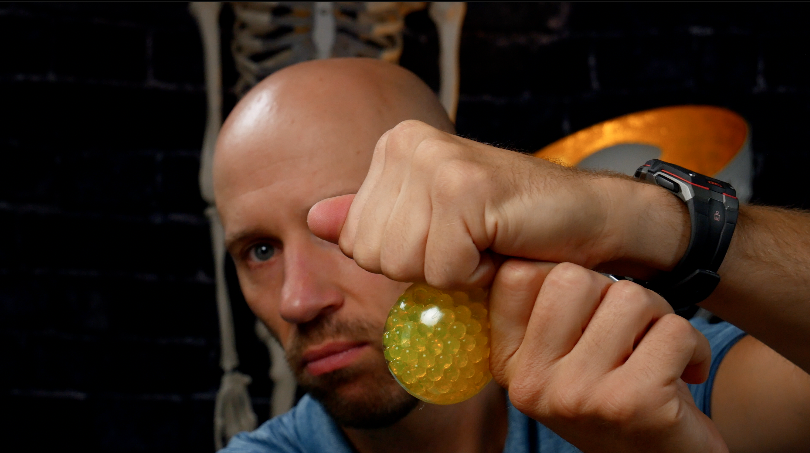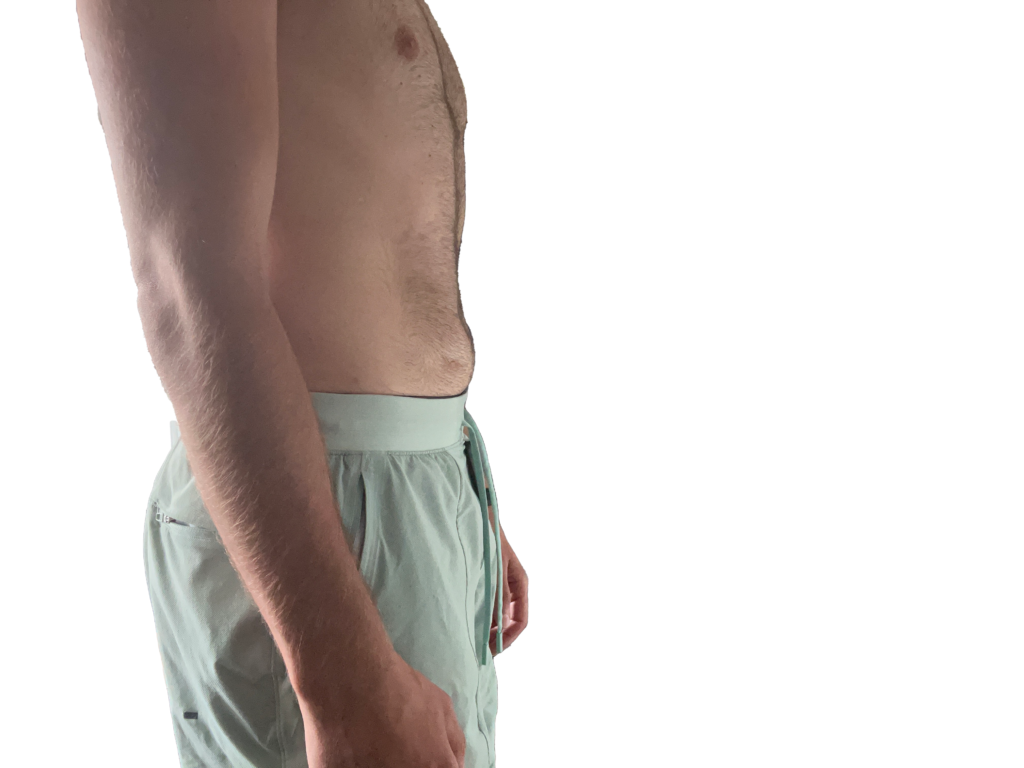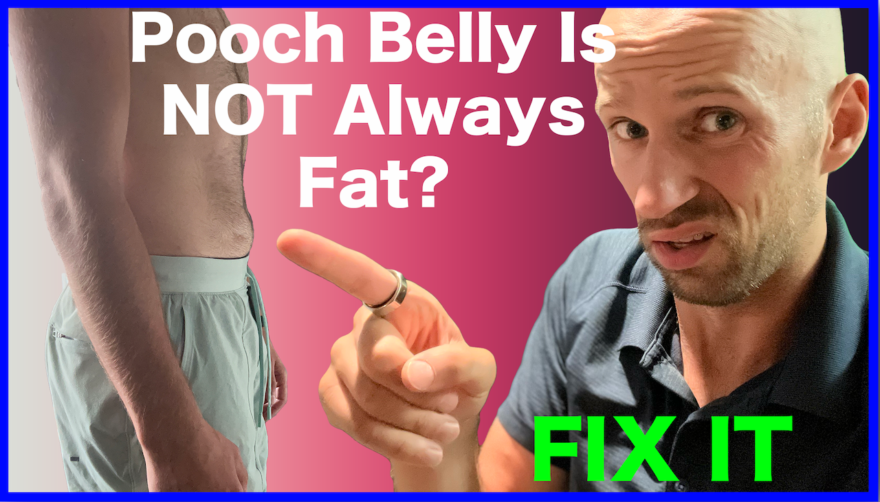Table of Contents
Is there more to getting rid of a pooch belly than just losing weight?
Are you someone who despite your best efforts has the lower part of your abs sticking out (aka a pooch belly)?
Maybe you’ve tried to lose weight, but it still remains.
What if there was a way to improve this area that didn’t involve extreme weight loss?
I think there is, and there’s research to show it.
In this post, you will learn how movement and body structure can influence where your abdominal contents sit (one underappreciated reason for the pooch), and how we can use movement to potentially improve this posture.
Intrigued? Check out the post and video below to learn more.
Pooch belly biomechanics
Many of us have who have a little bit of extra body fat have pooch bellies, but not all. What gives?
The answer may have to do with the dynamics of our body structure.
This study illustrated a theoretical mechanism for the lower ab bulge. If there is a lack of co-contraction between the pelvic floor and deep abdominals, the pelvic floor may descend, and the lower abdomen may bulge outwards (aka the pooch belly).
Look at it this way. The abdominal viscera (aka the guts) are moving downward and forward because one’s body structure may create biased increased muscle activity in the following areas:
- Upper abdominals
- Lower back musculature
And decreased muscle activity:
- Lower abdominals
- Pelvic floor
If you are having difficulty envisioning the guts moving this way, imagine squeezing the top and back portion of a toothpaste tube. Where would the toothpaste go? Down and forward.

Now you might be wondering why I briefly mentioned body structure, and that is for good reason:
Certain genetically determined body structures create the above movement tendency, so the degree the pooch belly can be altered is idiosyncratic.
If you are someone who has a narrower ribcage (narrow infrasternal angle), which is one reason I have this tendency, you will tend to have your abdominal contents sitting lower and more forward. This is normal. Read that again. THIS…IS…NORMAL.

Conversely, someone who has a wider ribcage (wide infrasternal angle) typically will not have the same resting gut position. Because these structures generally have more muscular activity in the front portion of the pelvic floor, their abdominal contents generally sit higher up (e.g. someone who has a rounder belly shape).

What are we to do then? Are we “screwed” because of mom and dad building us this way?
While we can’t change our structural tendencies, there are some ways we can increase our movement capabilities, which could alter the resting posture that we have in our abdominal wall.
Here’s what I’d be doing.
Pooch belly removal strategies
Aside from the biomechanical stuff I’m about to show you, there are two non-movement strategies that have to be considered when dealing with the pooch belly:
- Excess body fat
- Gut issues
- Pathology
Yes, folks, one could possess a pooch belly because that is where that person tends to carry body fat. A safe fat loss program could be essential for minimizing the degree of the pooch belly. As someone who personally tends to this posture, the leaner I get, the less pronounced it is.

Also, someone who has gut problems (e.g. bloating, constipation) could also be a contributing factor to having a pooch belly. Again, as someone who dealt with this, working on things that improve gut health could also assist with reducing the pooch belly.
Worse yet, structural pathology (cysts, etc) could also produde the stomach (aka get checked by your doctor fam!).
All 3 of these topics go beyond the scope of this post.
THAT SAID.
You can still see this pooch belly in lean folks who don’t have gut problems. So the other component that we may need to address is the biomechanics.
Considering that the guts are sitting down and forward, we want to use strategies that will bring the guts backward and upward. Aka activities that encourage us to engage the lower abs and ascend the pelvic floor.
Here are the easiest ways to do this:
Step 1: Differentiate pelvis and lower abs
I have a challenge for you.
Get in the hooklying position and place your hands on your lower abdomen. Try tucking your hips, and tell me if you can do this action WITHOUT engaging your abs.
Hard, right? Acquiring the ability to move the pelvis independently of the ab wall is the first step toward minimizing the pooch belly.
Commonly, people will utilize the upper abs to attempt to initiate the tuck. We want to see if we can use the glutes and hamstrings to create this.
What you want to do here is as follows:
- Think about your back pockets being pulled toward your heels
- Keep lower abs relaxed as you do it
If it’s too difficult with feet flat on the ground, you can elevate your feet to make it easier.
If that position is still too tough, then I would practice this action in sidelying instead, that way you take gravity out of the equation:
Step 2: Use gravity to reduce the pooch belly
If gravity is pushing the abdominal contents downward and forward, what happens if we work on flipping ourselves upside down? Now, gravity can assist in pushing the guts upward. WINNING!
To take advantage of this concept, we want to keep the hips higher than the torso.
The easiest way to start this progression is by using something like a quadruped on elbows exercise:
With this, we want to ensure that we are exhaling softly and slowly with super quiet inhales. This breathing strategy will ensure that we minimize upper abdominal engagement, which would push the viscera downward. You may even think about making your lower abs smaller as we did with the previous exercise.
You can make this exercise more effective (and difficult) by elevating the legs higher:
If you want the most challenging and effective way to utilize this concept, performing headstand variations can be quite helpful. CAUTION: these are a LOT harder, so the tendency to crunch (which would push the viscera downward) is higher.
KEY – keep the chest parallel to the wall
Just like with the quadruped on elbows, we can elevate our legs here as well:
Step 3: Dynamic reduction of the pooch belly
The previous interventions were fairly passive in nature. Is there a more active way to “fix” this issue?
I think so.
In fact, we can combine the gravity assistance above with a rolling exercise that if you do it right essentially forces the guts to go upward.
While I’ve experimented with different rolling exercises to achieve this goal, the best one I’ve been using I learned from my dear friend Joe Cicinelli. To ensure he hates me for making him famous, I call it the Cicinelli turtle roll.
I like this move because keeping the yoga block in place and NOT moving your head basically forces the guts upward. Otherwise, you can’t finish the roll.
There’s also a nice progression in place here, as you can alter the difficulty by changing which side of the yoga block you use. The closer your elbows and knees are, the more difficult it becomes.
Sum up
Now you have almost ALL of the considerations needed to improve a pooch belly posture.
To recap:
- Pooch bellies occur when the lower abs and pelvic floor do not coordinate well together, causing the abdominal viscera to sit downward and forward
- Certain body structures have a natural tendency for the abdominal contents to sit in this area
- Losing body fat and improving gut health could play an important roll in reducing the degree of pooch belly
- Teaching one to bring the guts upward and backward by pelvic differentiation, inversion, and rolling can be a useful strategy for reducing the degree of pooch belly
What struggles have you had with reducing the pooch belly? Comment below and let the fam know!

